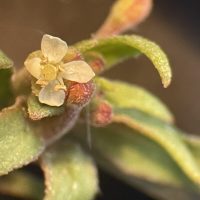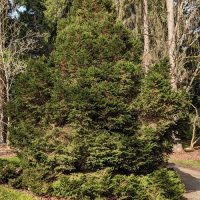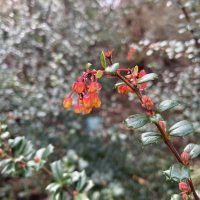Volunteers Make a Great Find

In early June, Rare Care volunteers Mickie Chamness and Janelle Downs stumbled upon a population of small evening primrose (Eremothera minor), a state sensitive plant species. It was actually on their way to another primrose monitoring assignment that they noticed the small population of 30 plants in the tracks of the dirt road they were hiking. This population of small evening primrose is one that Rare Care had previously searched for three times in that exact location, but never found any.
Read moreClimate Change Vulnerability in the Alpine

This past September, Rare Care completed a three-year study to assess the vulnerability of rare alpine plants. Working with the National Park Service (NPS), Rare Care staff and seasonal interns mapped and monitored 159 populations found in National Parks in Washington to climate change, installed 26 long-term monitoring plots, collected seeds, assessed 26 focal species’ vulnerability to climate change, and developed adaptive management strategies that NPS could employ to mitigate the impacts of climate change.
Read moreThe Weekly Dirt 04.12.23
04.12.23
Around The Farm
By Perry Acworth, UW Farm Manager
Seattle Sister City is First in France to Offer Degree in Urban Agriculture
A year ago three delegates from Nantes, the sixth largest city in France requested a tour of the UW Farm. With the help of a translator, provided by the Seattle-Nantes sister City Association, and vocabulary learned from my high school french language class decades ago, I explained how we manage three different models of urban farming on campus and how we engage with students.
Spotlight on BES 491 undergraduate research student: Brandy Eckman
Champion Trees of Washington Park Arboretum
What is a Champion Tree?
A Champion Tree is the biggest tree of its species in either circumference, height, or spread (how far the branches spread out to either side). Their measurements are given a point valuation in American Forest Points and then sent to either the state, national, or international registry who all keep track of Champion Trees with the highest point values in each species.
Read moreThe Weekly Dirt 04.05.23
04.05.23
Around The Farm
By Dan Cook, UW Farm Community Volunteer and Seattle home gardener.
Jamming, Part 3 – The Final Chapter!
OK, two weeks ago, I talk about making fruit jams, and last week I talked about the equipment I use for my jamming. This week I will talk about the step-be-step process of converting the ingredients into Tasty Jam!
An Afternoon Walk at the Washington Park Arboretum

1) Picea abies Norway Spruce
This evergreen conifer displays a beautiful pyramidal shape that adorns the entrance of the Asian Maples when coming from the Graham Visitor Center.
In its native habitat, the mountains of northern and central Europe, this tree matures to 100 – 150 feet tall. However, naturalized trees planted in temperate regions of North America mature to 40 – 60 feet tall.
The Weekly Dirt 03.29.23
03.29.23
Around The Farm
By Dan Cook, UW Farm Community Volunteer and Seattle home gardener.
Jamming! Part Two
In last week’s newsletter, I started talking about making fruit jams, one of the easiest and tastiest ways to get started with preserving food. I provided you with one of my go-to recipes for making blackberry mango jam, and discussed the various ingredients (fruit, sugar, pectin, citric acid) that make up the recipe.
The Weekly Dirt 03.22.23
03.22.23
Around The Farm
By Dan Cook, UW Farm long-time volunteer
Jamming! Part One
When my wife, Lily, and I moved from Las Vegas to Berkeley, California, we started growing tomatoes in a small 10’ x 20’ garden plot in the front of our rental house. We were soon facing what any successful urban farmer faces at some point in time, that is, the “too much produce” dilemma.
The Weekly Dirt 03.16.23
03.16.23
Around The Farm
By Kove Janeski, UW Organic Farming and Operations Lead, Landscape Architecture Masters Student
Coming Soon: Wapato Pond
As Seattle’s growing season ramps up, the Farm team is working hard every day to get our plots ready for this year’s crops. In addition to these seasonal tasks, the Farm is also focused on larger, long-term projects. One of these projects is the construction of a pond for the cultivation of Wapato (Sagittaria latifolia).
Read moreEvergreen Barberries at the Washington Park Arboretum

1) Berberis darwinii Michay, Darwin’s Barberry
This thicket-forming evergreen shrub is native to Chile and boasts small holly-like leaves, profuse orange blossoms, dark blue berries, and ample thorns.
Darwin is usually credited with “discovering” this species, however, it was known and used by Indigenous populations long before he collected it.
Michay is a serious environmental weed in New Zealand and is on the watch list in California.